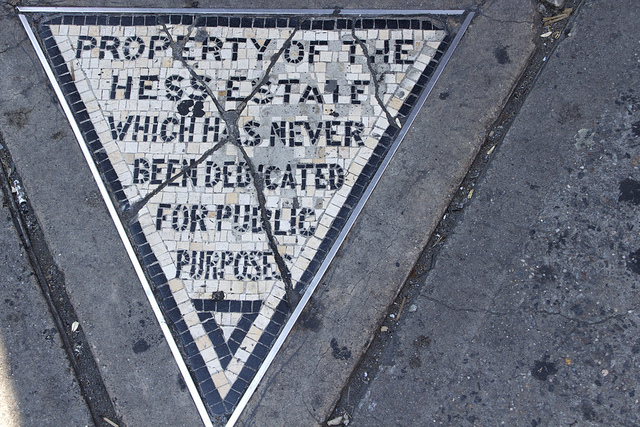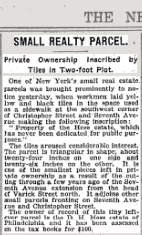You’ve got the Empire State Building. You’ve got the Brooklyn Bridge. You’ve got Central Park and Times Square and Grand Central Terminal and any and all manner of behemoth landmarks that represent New York City.
Then there’s the little bitty triangle of defiance on the corner of Christopher Street and Seventh Avenue South. It is all of 500 square inches, inscribed with tiny tiles that, 95 years later, still bellow out a message that has long made New Yorkers ask: Wait, what?
We’re talking about Hess Triangle.

Hess Triangle. (Source: David Gallagher via Flickr Creative Commons).
The story has been told many times since this unusual, private niblet of New York City was memorialized in a July 29, 1922 story in The New York Times. Still, while the piece of land is likely the smallest private parcel in all of New York City, the gargantuan lesson of this swatch of ground deserves repeating.
The story dates back to around 1913, when New York City officials condemned about 300 buildings and assorted pieces of property in order to extend Seventh Avenue and make room for the IRT subway to run below Greenwich Avenue. The eminent domain effort included the Voorhis Apartment, owned by David Hess, which sat right on the spot where the city was going to broaden the road.
After fu tile attempts to save his property from demolition, Hess discovered that, due to a survey error on the city’s part, the city had inadvertently left Hess with a small triangle, all of about 27½ inches x 27½ inches x 25½ inches. The battle between the Philadelphia-based landlord and NYC officials did not end there, though. The city then wanted Hess to donate the triangle so as to incorporate the slice into the new sidewalk. But Hess refused. He took his battle to court and emerged with the triangle in hand, so to speak. The city assessed it at $100 on the tax rolls.
tile attempts to save his property from demolition, Hess discovered that, due to a survey error on the city’s part, the city had inadvertently left Hess with a small triangle, all of about 27½ inches x 27½ inches x 25½ inches. The battle between the Philadelphia-based landlord and NYC officials did not end there, though. The city then wanted Hess to donate the triangle so as to incorporate the slice into the new sidewalk. But Hess refused. He took his battle to court and emerged with the triangle in hand, so to speak. The city assessed it at $100 on the tax rolls.
The New York Times‘ story calls out the “considerable attention” drawn to the parcel, especially on July 27, 1922, when workers used black and yellow tile to lay down the final “Up Yours” cry from Hess to the city of New York.
The declaration of victory, no matter how small, remained in the Hess estate until the 1930s, when the estate sold the triangle to the owners of the cigar store on the corner. The price was $1,000. And there it sits to this day, a message for all the world to see and remember: You can fight city hall.
Related:









